牛津译林版英语八上(初二)U8 Integrated skills (共20张PPT)
- 格式:ppt
- 大小:2.80 MB
- 文档页数:20
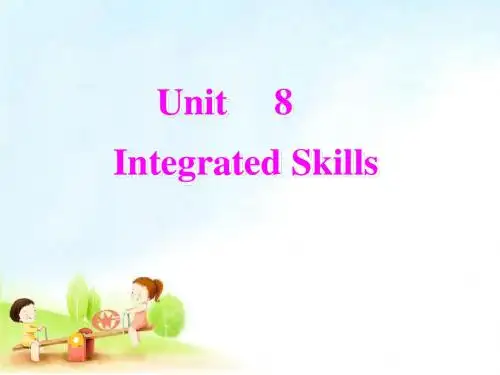

Unit 8 Natural DisastersIntegrated skills 教案I. Teaching aims and learning objectivesBy the end of the lesson, students should be able to:1. know what phone number to dial for help;2. get the useful information while listening and develop listening skills;3. talk about first aid in simple English;4. know how to protect themselves.II. Teaching contents1. New words and phrases: as … as possible, towel, railway, protect oneself from, stay low to theground, follow traffic rules, burn;2. New structure: Try to get out as soon as possible.Hide under a strong desk or table to protect yourself.Cover the burn with a clean towel.III. Focus of the lesson and predicted area of difficultyUse the important words and phrases correctly and fluently.Talk about first aid in simple English and know what to do first to deal with some accidents.IV. Teaching proceduresA.Away from dangerStep 1 Lead-inWatch a short video about fire.T: This year I saw a fire. This is the first time in my life I saw fire with my own eyes. And I kept it in my QQ zone. Please have a look. Can you guess my feeling at that time?T: Yes, I was nervous and frightened. My heart was beating fast and my hands were shaking.Did I just stand aside and watch it burning? Of course not. I made some phone calls. At first I called 120 for help. They told me they would go there quickly and they advised me to call 119.You know the difference between 120 and 119?T: Yes, if a building is on fire, we should dial 119 for help. If someone is hurt, we should dial 120 for help. But at that time I was too nervous and I had mixed feelings about what phone to call first. So you see when something unusual happens, the most important thing for us to do is to keep calm and then try to find a way out.【设计意图】通过和学生讨论自己的亲身经历,让学生对我国一些特殊的电话号码有感性的认识,同时引导学生认识到保持冷静、以及伸出援手的重要性。
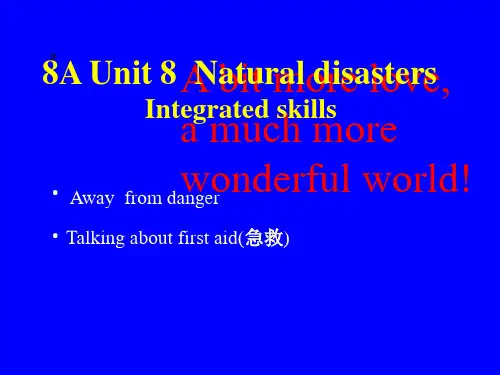
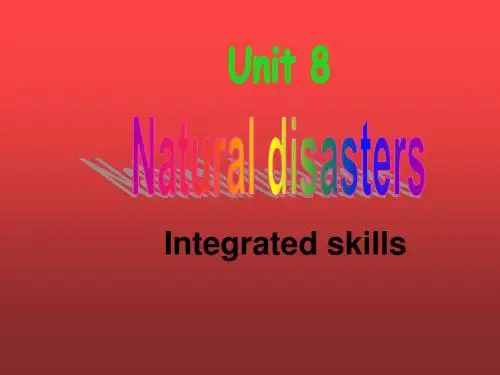
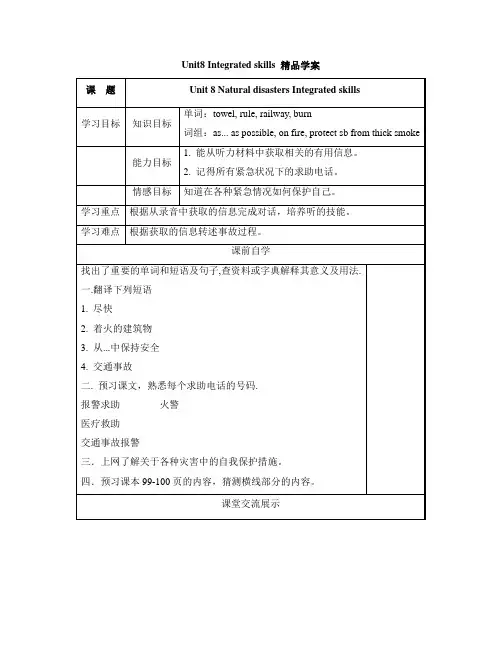
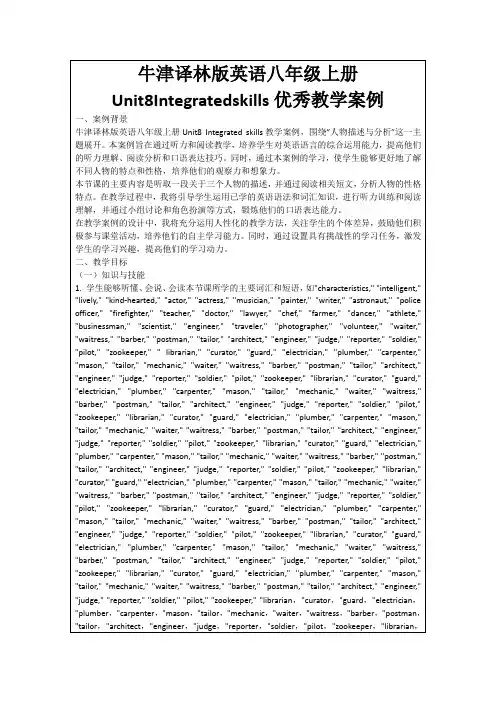

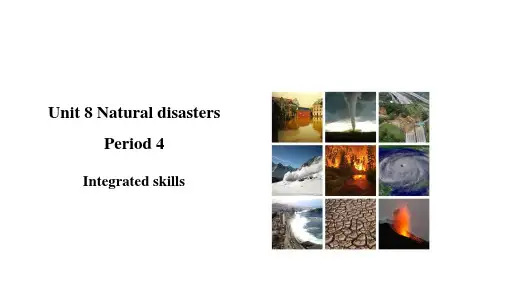

8A Unit8 Natural disasters第7课时Integrated skills班级____________________姓名__________________自我评价__________________ 【学习目标】1. 知识目标:①了解紧急求助电话中需要用到的关键表达法。
②识别阅读和听力材料中呈现的信息。
2. 技能目标:①能根据从录音中获取的信息完成事故报告单,培养细听技能。
②能根据获取的信息转述事故过程。
3. 情感目标:知道遇到危险情况时要及时地向警察、家人或朋友求助。
学习过程【预习指导与检测】(一)预习指导1. 预习P102-103的生词,做到会读会背知其义。
2. 理解P102-103 A部分的题目要求,试做A1和A3的部分习题。
3. 朗读P103 B部分的对话,并且自编一则对话。
(二)预习检测一、根据句意和首字母或中英文提示完成单词。
1. During the snowstorm, the 110 h__________ received a call from a man.2. Their car c___________ into a big tree and it was broken.3. Don’t worry about yourself. There’s nothing s__________.4. The road is ___________ (覆盖) with snow.5. Let’s send these ___________ (幸存者) to the safety.6. The rain was really __________ (大). A number of people were wet all over.7. Do you know the time of his ___________ (到达)?8. To save the children in the fire, two __________ (fireman) lost their lives.9. Somebody called you just now. The __________ (call) said she was a friend of yours.10. It is going to be __________ (wind) tonight. Please close your windows.二、认真阅读课本P102-103,相信你能把下列短语译成英语。
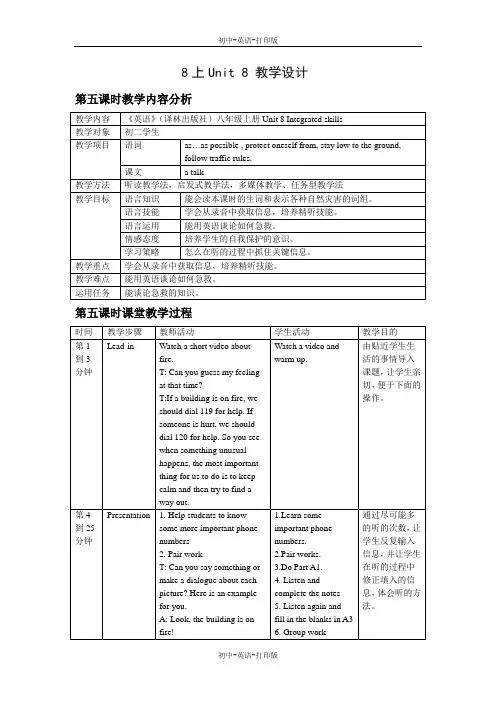

牛津译林版-英语-八上-8单元Naturaldisastersintegratedskills初中英语牛津译林版八年级上册Unit 8 Natural disasters integrated skillsContent: In tegrat ed skillsPeriod:10-7Teaching aims and demands:1.To understand the process of producing an accident report form.2.To grasp the key expressions used in an emergency call and an accident report.3.To know more about what to do at the time of meeting an accident.Key points:1.The key expressions used in an emergency call.2.How to make you rself safe when there is an accident, a natural disaster or other dangerous things. Difficult points:1.The methods of keeping oneself safe from an accident or a disaster.2.Teaching methods: listening and task-based methodsTeaching aids:A tape recorde rTeaching methods:Listening and discussi onTeaching procedures:复备栏目Step 1 Revision1.Revise the past continuous tense with some exercises.2.Talk about different kinds of weather and disasters with some pictures. Getthe students to guess what bad weather or a disaster can c ause or start.Step 2 PresentationShow a picture of a snowy day and get the students to answer the questions.1.Is the world all white? (Teach the word ‘cover’ )2.How is the weather? ( Teach the word ‘condition’ )3.What may happen in this kind of days? ( T each the phrase and the word‘fall over,victim’ )4.What will you do if there is an accident? ( Teach ‘hotline, mobile phone,caller, serious’)Step 3 Listening and completing1.Get the students to listen to the tape carefully.2.Ask the students to complete part of the accident report form in Part A1 onPage 102.Step 4 Asking and answeringGet the students to listen to the tape again and answer the followingquestions:1.What was the date of the call/the time of the call/the time of arrival/theplace of the accident/the name of the caller?2.What were the weather conditions?3.How many victims?4.How are the victims now?5.What did the policemen do?Step 5 PracticeGet the students to complete the accident report form on Page 102.Step 6 Production(Pair work)1.Ask the students to read the information on Page 102. Then get them tomake up a dialogue between an interviewer and Mr. or Mrs. Su with thequestions like the following:What happened to you, Mr. Su?Were you alone in the car?Why didn’t you get out by yourself?Was anyone hurt?Did you call someone for help?Wh at do you think caused the accident?2.Act out the dialogues.Step 7 Practice(Completing)Get the students to complete the e-mail in Part A3 on Page 103 according tothe information on P age 102..Ask the students to read the e-mail on Page 103.Step 8 PracticeGet the students to discuss the ways of staying safe when there are someother disasters?Do some consolidation exercises.Homework:1.Make a report form when there are other accidents or disasters.2.Finish the rest exercises.3.Revise what you’ve learnt in this period.4.Get ready for the next period:Make up similar dialogues like the one on Page 103./When do we drop ourvoice when we speak?教学反思:达标检测Unit 6 Integrated skills (40’)一、用所给单词的适当形式填空:(16’)1. the policewomen (watch) the traffic or (have) a rest from seven to nine yesterday morning?2. Jim (draw) a picture in his room at 4 yesterday afternoon.3.---What you (do) during the Spring Festival?----I (visit) Thailand at that time.4. ---Why didn’t you go to the party last night?---I (wait) for an important call from Shanghai.5. What you (do) when I knocked at the door?6. While my mum (cook), my dad (read) newspapers.7. While/When the children (have) lessons, the earthquake (start).8. While Daniel (make) a snowball, he (fall) over.二、根据所给提示或单词,用其适当形式填空:(11’)1. All of us were excited about his (arrive).2. Ability is one of the (condition) of success(成功) in life.3. The teacher looked at the students (serious).4. Look, snow c everything. How beautiful!5.The fish smells t . Throw it away, please.6. The c of my health stops me from working.7. Don’t worry, madam. There’s nothing s .8. He called the 110 (热线) at 7:40 p.m. (use) his (手机).9. The building caught fire because lightning (hit) it.三、将下列短语译成英文:(10’)1.撞到一棵树上2.盖住所有的东西3.打电话人的姓名4.受害人的数量5.受害人的情况6.又冷又怕7.打110热线8.用手机9.坏天气可能很危险10.读报上有关汽车事故的文章四、将下列句子译成英语:(3’)1.在那次地震中,遇难者人数超过一万人。
主备人审核人授课时间年月日第课时课题课型新授课教学目标1.To learn to know dial some important telephone numbers for help.2.To know how to protect yourself when there is a disaster or an accident.重点1.To learn to know dial some importanttelephone numbers for help.2.To know how to protect yourself whenthere is a disaster or an accident.难点To know how to protectyourself when there is adisaster or an accident.教法及教具教学过程Step 1. Words and expression reviewas…as possibletowelrulerailwayburnStep 2. Away from dangerMany people like snow because it looks really beautiful, but sometimes it can causeproblems. What problems can it cause? Please take a look at the pictures on page 99. Whichone is about a traffic in a snowstorm? What happened to them? What should they do?A snowstorm can cause traffic accidents. When they are in danger, they should stay calmand dial 122 for help. Now please talk about the other three pictures in groups of four. Pleasedescribe each picture and find out which number they should dial.It is important to know how to protect ourselves when there’s a disaster or an accident. Thestudents are attending a talk called “Away from danger” at Sunshine Hall. Listen to the talkand help Simon complete his notes.Danger TipsFires : Try to get out as soon as possibleCover your mouth and nose with a wet towel to protect yourselffrom ___________Stay ____ to the groundNever ________ into the building on fire尽可能n. 毛巾;浴巾n. 规则n. 铁路n. 烧伤,烫伤,灼伤110-Police119-Fire120-Hospital 122-Trafficthick smokelowgo backhighwalkHideWindow教师主导活动学生主体活动教学内容个案调整教师主导活动学生主体活动Floods: Get to _____ ground and stay hereDo not _______ through the flood waterEarthquake: ______ under a strong desk or table to protect yourself Do not stand near a________.Traffic accidents:Always ________ traffic rules.Look ______, right and then left when you cross the roadDo not sit, ______or ride your bicycle on railways.Simon’s cousin Annie is asking Simon about the talk. Help him answer Annie’s questions. Listen to the talk again and check your answers.Step3. Speak up: What should we do first?1.It is important to know how to stay away from danger, but sometimespeople do get hurt. Do you know what should you do first? Millie and Daniel are talking about first aid. Listen to their conversation andanswer the following questions.1.What to do first when people burn their hands?2.What should they do after that?3.Should they put any cream on it?2.TalkWork in pairs. Tell your partner about fi rst aid. Use Millie and Daniel’s conversation as a model.Step4. Homework followleftwalktraffic accidents get outwet towellowhigh ground walkstrong windowtraffic rules railways1.Theyshouldkeep theirhand incold waterfor abouttenminutes. 2.Cover theburn with acleantowel.3.No, theyshouldn’t.Theyshould goand see thedoctor.板书设计教学札记教学内容个案调整教师主导活动学生主体活动。
Unit8 Integrated skills 参考教案I. Teaching objectives1.To extract key information about a traffic accident from listening2.To develop intensive listening skills3.To complete an accident report using the information through listening4.To talk about traffic accidents and natural disastersII. Teaching proceduresStep1.Pre-listening1. Tell students that bad weather can cause natural disasters sometimes and bring a lot of serious problems to us and today we will meet such a couple who suffered from bad weather.2. Show a picture of Mr. and Mrs. Su. Ask some questions about it, e.g. What’s the weather like? What has happened to them? Discuss the questions with students and present the new words: weather condition, cover, victim, caller, and hotline. Then explain the context of this section. The two persons are Mr. and Mrs. Su. One day, they had a car accident during the snowstorm and called the 110 hotline for help. Then the police came and saved them.3.Show a table and explain this table is a police report. Ask students to look at it carefully and ask and answer questions about it with their partner. For example: When did the police get the call? Where did the accident take place?4. Tell them there is also an accident report from the 110 hotline. Ask them to open their books, complete part of the accident report form in Part A1 with as much information as they can find in Part A2. Then check answers with the whole class. Step 2 While-listening1. Play the tape and ask students to listen to the phone call between Mr Su and the officer of the 110 hotline. Then fill in the missing information in the accident report form in Part A1. If necessary, play the tape and ask students to listen again, pay special attention to the information they should write down. Then check answers with the whole class.2. Ask students to do a pair work, one plays the role of Mr. Su, and the other acts asthe officer of the 110 hotline. Invite them to make a telephone call using the information in the accident report form.Step 3 Post-listening1. Tell students that Sandy read about Mr. and Mrs. Su’s accident in the newspaper. She wants to tell her e-friend Vivien about it. Ask them to help her complete her e-mail in Part A3. Then check answers together.2. Students read the e-mail together.3. Explain that a reporter from a TV station asked Su Ning to introduce what he and his wife experienced that day. Tell students: If you are Su Ning, please tell the audience about it using the topic ‘My experience during the snowstorm’.Step 4 Speak up1. S ay from Mr. Su’s story, we know bad weather can be really dangerous. Sometimes, it can even cause natural disasters. Ask students to listen to a conversation between Sandy and Amy. They are talking about such a natural disaster caused by bad weather.2. Students listen to the tape and answer these questions:No.1 What happened to Vivien’s school last week?No. 2, What caused that disaster?No. 3, Was anybody hurt?3. Students read the conversation in pairs . Then invite some pairs to come forward and role-play it in front of the class.4. Ask students if they have heard about the Taiwan earthquake in 1999. Go through some details about that earthquake with the class.5. Ask students to tell their friend about that disaster. They can use Sandy and Amy’s conversation as a model and replace the underlined words with their own ideas.6. Students can talk about any other natural disasters they have experienced or heard about with their partner.。